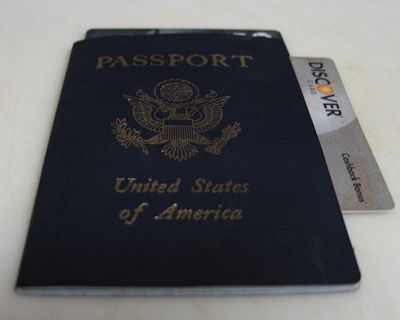Travel Tip – International Credit Card Fees

It’s something you don’t hear talked about regularly. One of those little surprises that the diligent and thorough will discover after returning from an international trip as they pore over their credit card statement.
Most travel blogs and credit card companies warn you about the importance of calling your credit card company immediately before an international trip to notify them that you’ll be out of the country and that it’s acceptable to approve international charges. What they usually don’t talk about is currency exchange fees, transaction fees, and international ATM fees – all of which add to the cost of travel.
In preparing for my upcoming trip I made a few calls and did a bit of research. What I have learned is that all banks have slightly different policies and approaches to international fees and the only way to truly know where you stand is to call and ask. Luckily, while some of the agents don’t have the rates memorized they can pull them up and let you know quickly and easily. Just call the service number listed on the back of your credit or debit card.
As I prepared to travel I dealt with my three providers: Citi Bank, Bank of America and Chase Bank. It’s interesting and perhaps important to note that none of the banks were willing to wave or negotiate the fees (and believe me I tried).
There are two different fee structures to be aware of. One for international Credit Card use. The other for international debit card/ATM use. These fees are especially obnoxious because you’re probably getting hit in 2-3 areas.
Debit Cards:
Chase told me that international use of their Visa debit cards came with a 3% currency exchange fee and a $3 ATM use fee. Then on top of that add on whatever ATM transaction fee the international bank chooses to charge for supporting an out of network bank. Unfortunately, I failed to confirm what the use fee was for retail transactions using the Chase Visa debit card. I believe they are at least 3%.
Bank of America was a bit more thorough in providing me with a breakdown of specifics. A Visa debit card through them results in a 1% currency exchange service fee. The gal I talked to failed to give me the specifics on their out of network ATM fee, which I assume is between $2-$4. She did note that the B of A fee is waved if you use one of their partner bank ATMs. Unfortunately there is no escaping the 1% conversation fee. Interestingly, she did note that they have 29,000 “Visa” ATMs and 19,000 “Plus” ATMs in Spain. If you use your debit card anywhere besides their ATM they charge a 3% currency exchange fee for retail transactions using the Vista debit card.
The only way you can get the ATM fee waved seems to be if you tie it to a rather large bank account. Definitely not an option most 20 somethings will be able to take advantage of, though it is a possibility for families or retirees looking at traveling. You might also be able to leverage a business account to get the fees waved.
Credit Cards
For convenience reasons when traveling in Europe, I prefer to use either Visa or MasterCard. Unfortunately, Discover isn’t accepted internationally, and AmEx seems to have significantly less coverage. I highly recommend researching what cards are most commonly accepted in the region of the world you’re planning to visit.
In calling, I found that both Bank of America and Chase set their Credit Card transaction fee at 3% on every transaction for their Visa cards. Contrary to some of the material I’ve read on the web, the 3% fee seemed to be fairly common across the banks I talked to when dealing with Visa cards. Again, despite raising a considerable fuss about the issue, neither bank was willing to adjust the rate.
I was able to confirm that B of A and Citi both place a 1% transaction fee on their MasterCard credit cards. While not positive, the way the B of A representative referred to the fee it’s set by MasterCard. Though it’s also probably subject to the individual credit card/bank contract.
My experiences seem to line up fairly well with the following survey done by IndexCreditCards.com which found:
How do the major credit card issuers stack up? Below are the international transaction fees from each issuer (for banks that issue Visa or MasterCard branded cards, these numbers include the Visa or MasterCard fees):
- Capital One: 0% transaction fee. (Capital One not only doesn’t impose its own fee, but it also eats the 1% fee that Visa or MasterCard impose.)
- Discover: 0% transaction fee
- American Express: 2% (Increasing to 2.7% January 1, 2009)
- Pulaski Bank: 2%
- Barclays/Juniper Bank: 2%-3%, depending on card
- Bank of America: 3%
- Chase: 3%
- Citibank: 3%
- GE Money 3%
- HSBC: 3%
- U.S. Bancorp (U.S. Bank): 3%
- Wells Fargo: 3%
I prefer using a debit card for cash withdrawals over currency exchangers or travelers checks, and a credit card for the lion’s share of my other purchases. For this trip I’ll use my 1% cash back MasterCard which – when the dust settles – should negate the 1% fee they’ll be charging on every purchase. A side note: Don’t assume that airline miles cards have better travel rates. From what I’ve seen they’re treated exactly the same as any other card…so as much as it may pain you, you might be better off leaving the Mileage card at home.
Tips, suggestions or additional ideas? Please share them in a comment form below. Was this post useful? I’d love your feedback.


Super fantastic post, totally useful!
Super fantastic post, totally useful!
Great info. Would you have to activate a BoA debit card for intl travel? My wife is in Peru and none of the ATMs are accepting her card. It’s either that or pay exorbitant Moneygram/WestU fees.
Great info. Would you have to activate a BoA debit card for intl travel? My wife is in Peru and none of the ATMs are accepting her card. It’s either that or pay exorbitant Moneygram/WestU fees.
Marcos and Kim – Thanks for the kind words!
Marcos, it should work. It sounds like a security lock may have been placed on the account/card or that she needs to find a different type of bank ATM. I know some can be a bit picky, though most are fair game.
Best bet is to call and get the details for the card, and make sure that they truly flagged it for international travel.
Marcos and Kim – Thanks for the kind words!
Marcos, it should work. It sounds like a security lock may have been placed on the account/card or that she needs to find a different type of bank ATM. I know some can be a bit picky, though most are fair game.
Best bet is to call and get the details for the card, and make sure that they truly flagged it for international travel.
Good post, you reaslly have to be careful with overseas credit card fees as some cards are very competitive and others add crazy surcharges. Here is Australia the banks tend to charge high rates.
Very nice blog. I enjoy reading it. You really provide us all the needed information about traveling and rates when traveling.
GREAT RESEARCH……thanks
GREAT RESEARCH……thanks
In all my travels, I always make it a point to contact my credit card company letting them know that I will be out of the country. In doing so I will have less credit card rates to pay and will have little problems to worry about.
Thanks for sharing . This information is useful for me.
Thanks for sharing . This information is useful for me.
Thanks for this post
Interesting article you have here.Banks have many things that customers don;t know about if they don't ask there for we need to ask everything we need to know about our credit cards and acccounts.
if you plan to count pennies when traveling i would recommend you find the smallest back in the city you live. they will provide you more exact information and even allow you communicate directly with them via email while traveling. the larger banks have no reason to provide the personal service. having an account with a large bank and a couple small ones is the best option. even in the smaller bank scenario you can have bad and good. so make sure you open a few accounts months before and test them for personal service and communication.
.. and the more youre on the move the sooner you will find it is always better to use atms to withdrawal cash and limit the actual times you use a debit card. i left america with 4 different cards; BOA, a CU, and 2 very small locals. The best overall is the smallest bank. only 2 branches, the worst is the other small bank, and BOA and the CU are both good but do not have email contacts. trust me if you find yourself in a foreign country and need an answer have a person you know to contact on email is great. and i think if you play it right you can find someone who actually is interested in your travels and therefore provides you with some respect and quick responses. about 5 months before i left i scouted 10 banks, asking all the same questions. then i chose 4. opened accounts and tested them.
Good post!!
Great work…Keep it up!!
Pretty good blog. I just stumbled upon your web-site and wanted to point out that I’ve honestly enjoyed reading your web-site posts. I’ll sign up for your feed and I hope you publish another post again shortly!
Before our 3 month long trip to Europe last year, I also did a lot of research on this topic.
We happen to belong to a credit union besides two other major banks. Our banks were 3% as you found, but our credit union charged 2% on international ATM/ debit card transactions. So that was our go-to card. It all adds up.
Thanks for sharing so much of your experiences; both in planning and in photos.
Thanks Pam! Yep, everything I’ve seen and heard suggests that as long as you can get decent coverage a credit union is the best way to go for avoiding fees while traveling. What Chase charges me is absolutely criminal between the ATM fee and the exchange fees.
I got very excited when I saw that Capital One does not charge any transaction fee, so I called their 800 number to get more details. I was told that as of August 15, 2012, they will be charging a 3% fee like the rest of the banks… that popped my bubble as I will be leaving the 28th. And they will also be charging a $2 ATM fee for using non-Capital One ATM’s.
That is extremely disappointing to hear. Thanks for the heads up. The good news is that the other banks have started to kill their fees. I currently use a Chase British Airways card that has zero international fees and has a chip as well as magnetic bar. Try checking that out for your trip. Unfortunately there is an annual fee though.